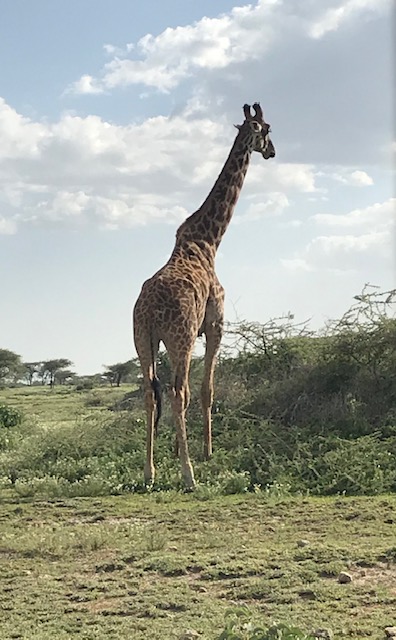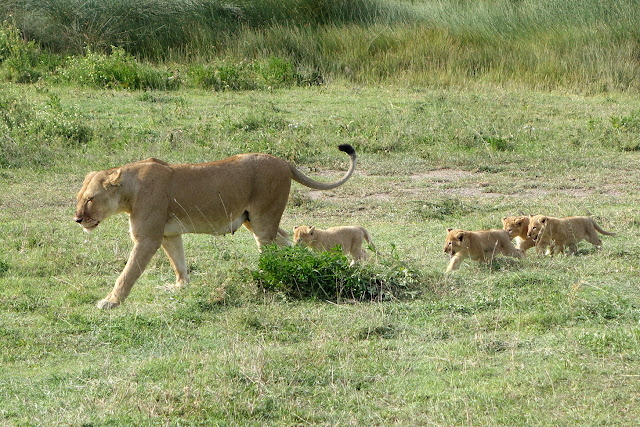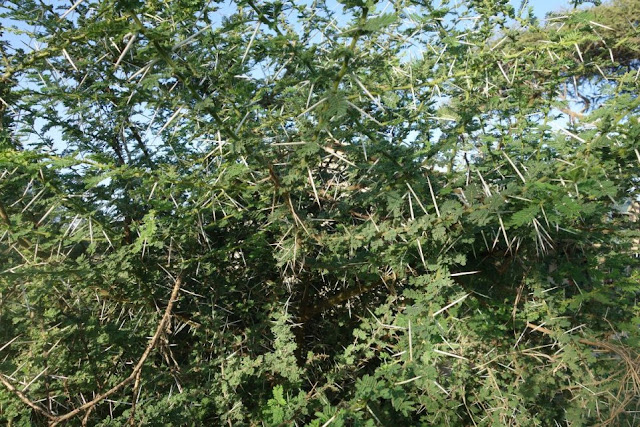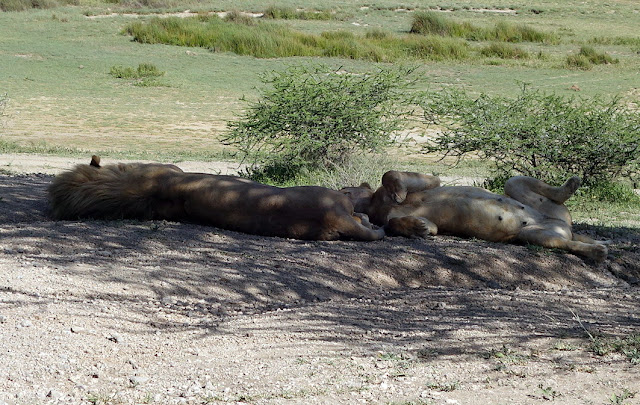This entry is long as we saw so many fascinating events in this area.
ENJOY THE PICTURES!! If you have time, read the comments and click on the purple words for more details on each.
 |
| Masai huts |
 |
| Masai boy herding goats |
 |
| Masai women walking down the road |
Below, a mock up of a mine with veins of tanzanite in green and orange.
A mother rock on the right
We continued down the main road. The speed limit on "highways" is 80 kph (or 48 mph) and 50 (30 mph) in towns and cities. Given the condition of the roads, it would not be wise to go faster.
We saw signs for the Ngorongoro Conservation Area
and our first sighting of zebras.
We stopped to shop a bit and for a lunch . We saw very impressive, large carvings outside the store.
 |
| The mane of this lion was amazing art |
 |
| A wildebeest carving |
 |
| Amazing carving of dozens of people |
 |
| A carved giraffe priced at $14,000 --probably could sell for half that? |
 |
| The Masai warrior who sold me a few items. He earns money for his community |
 |
| An oversized baboon with a feral cat under it. The cat had just gotten table scraps from people who ate their lunch nearby. We did not feed it. |
We drove by for an overview of the Ngorogoro Crater where a breeze was welcome at this 7,000 feet plus altitude. That was the last place we would have WiFi reception for the next three days.
 |
| Overlook of part of the Ngorogoro Crater |
We continued on, driving through a town, I think a Karatu village (the Wambulu tribe where they are sometimes called Iraq people as the women have soft hair like Arabs) and saw stores, produce for sale on the side of the road, and a father and son on a bike in front of a gas station.
 |
 |
| Masai Shoppers |
 |
| Older man in a store |
 |
| A lone giraffe looking around |
 |
| Flamingos in a lake--I love the clear reflections! |
 |
| A hyena fairly close |
The road was quite bumpy as we traveled along.
We also saw a large group of wildebeest with gazelles among them and zebras at the beginning and in the middle. It was getting late so we could not stop to take a picture but it was impressive.
We stopped to register at the NCA, the Ngorogoro Conservation Area.
The entry had a good display of the region. Here are some examples.
We were delighted to see all kinds of animals, but many people on safari look forward to seeing all of the "Big Five." The phrase "big five game animals" was coined by hunters and refers to the five most difficult animals in Africa to hunt on foot and not for their size and also because they are so dangerous. They include the lion, the African elephant, the cape buffalo, the leopard, and the rhinoceros.
We arrived at the Tingitana tented camp in the late afternoon, in time to settle into our tent, join a camp fire with snacks and then head to the central tent for dinner and to charge our phones/camera.
There are 11 tents at this camp with 15 men, three of whom are Masai, working there. Every such set up must have at least two Masai for protection from animals. The tents are portable and are moved as they follow the migration. They will stay in this site for another few weeks, then pack up and go to Arusha for repairs before heading out to the Serengeti for another three months.
The tents, based on wood planks, are huge and well maintained. They can sleep four to six people. Havazelet and I shared a tent and Nava and Helen shared another. The tents had two big rooms, the first with a queen bed and a chair and some tables, the next with two single beds or two sets of bunk beds, and then a shower, toilet, and sink area.
 |
| Helen outside of a tent |
 |
| Middle room |
 |
| Havazelet fixing her hair in the Bath Room area |
Light bulbs in the tents were solar powered. Water was transported in and then solar heated for showers and sinks, and then "turned on" when we returned from our outings.
Meals were delicious and the chef catered to our special requests, such as asking for .vegetables with our egg for breakfast.
The best thing is that there were no outdoor lights so we could see the beautiful night sky and hear the animals nearby. After dark, when we walked the short distance back to our tent, a Masai accompanied us and zipped our tents shut after we entered.
We heard lots of noises at nights, especially guttural sounds of lions that were close but not too close (maybe 3-4 miles, i.e. 5-7 km, away). They seem to be telling us, "This is MY territory." At dinner and before going to bed, we also heard elephants. .
We saw acacia tortilis trees close up and were impressed by the very sharp white thorns on them. Giraffes like the tender tips of acacia trees but have to be careful to avoid the thorns.
 |
| Three of us with part of this special staff |
 |
| Elementary guinea fowl |
 |
| Acacia trees, dead and alive |
 |
| Impalas--they usually like bush and treed areas more than open spaces |
 |
| Oops, this Toyota Land Cruiser got stuck in a muddy area. Fitiael and other guides helped pull it out |
Below is our first view of a lion and lioness resting very close to the side of the road.
Other vehicles stopped too and soon the two lifted up their heads.
They probably heard the wildebeest and zebras move and followed them into the bush. I wonder if they felt we were a disturbance?
As they walked off, we discovered a third in their group! The lion and two lionesses had been resting in the grass.
The group below totally ignored the vehicles watching them.
Then we saw another groups of 6 lions in a pride--two "brother" lions and four females, but only one of the males is the dominant (leader) one.
 |
| Superb starlings on the ground near the Land Cruisers and the lions |
 |
| And others in the air, including vultures, flying over previous kill by lions, who had eaten their fill |
These males are young as they have shorter manes. Older lions have manes that are closer to black and longer. The pride has an area of 15--20 square kilometers (5-7 sq miles).
The tufted tip of the lion's tail is used to communicate with other lions.
 |
Below are white hooded (or red throat) vultures on the ground to eat.
The lappet faced vulture is the largest with a wing span of three meters (10 feet). The white backed is the most common here. Griffon vultures are here too.
We were astounded to see a cheetah so close to our vehicle.
Cheetahs are the fastest animals on earth. They hunt gazelles, impalas, and baby wildebeests. The females are solitary while the males form a coalition (group). The tip of the female's tail is blackish, and she can signal her cubs with it. When she hunts, she hides her cubs from hyenas. Lions kill baby cheetahs to reduce the competition.
Cheetahs are awake during the day and have spots and black tear lines under their eyes to protect them from the sun. Leopards have multi colored circles and are nocturnal.
We soon ran into a group of three land rovers with back tires stuck in the mud. Ten drivers got our to help, with ours having the rope needed to aid the other drivers in their efforts.
We passed a group of about 8 zebras. Some are pregnant, but it can be hard to tell as they naturally look big through their middles. They roll in dust to remove parasites.
Juvenile zebras have brown and yellowish stripes, which later turn white .
Vultures waiting to feed.
Another lion and his kill below--probably a wildebeest.
We didn't spot a lot of flowers in this area, but here are a few small, low-lying ones we did see.
About an hour later, we spotted another cheetah!
Before heading back to camp for lunch, we saw a group of wildebeests walking in the distance and also, a steenbuck (or steinbok), a pretty, delicate looking antelope.
We again headed out in the late afternoon, following a delicious lunch .
We saw three Thomson gazelles (with black stripes on their sides) and 5 Grant gazelles, which are bigger with larger horns.
 |
| A Thomson gazelle |
 |
| A Grant gazelle |
And soon we came upon a huge group of wildebeests with zebras, walking along the migration trail along the salt water lake--it has an inlet but no outlet and the volcanic rocks here are salty.
Zebras can see very well and have good memories. They also can kick any attackers. Wildebeests have a good sense of smell (but cannot see well(, so they are good travel partners.
The black and white stripes of the zebra confuse predators because of the glare reflecting from them.
Though they look very different, the wildebeests are in the same family as the antelope. Note the nursing zebra baby in front of its mom in the center.
Wildebeests are the largest group of mammals in the park. (There are more than 1.8 million as part of the migration.) In Africa, most are concentrated in Tanzania and the Serengeti National Park. This was the calving season for the wildebeest (who live about 20 years) and we saw three in this huge group! After giving birth, the mothers drop the placentas so that hyenas will eat them and (hopefully) forget about the babies.The babies have to be ready to run in less than an hour after their birth.
Hyenas have very sharp teeth so can eat bones and clean the area.
We watched them for more than 30 minutes and more kept coming--at least ONE THOUSAND! It was definitely the highlight of the afternoon!!
I just saw the movie TREK on Netflix. I strongly recommend it. You can see the birth of a wildebeest and its need to run for its life in less than 30 minutes after its birth.
We drove further along the lake and saw a Maribou stork in front of the flamingos.
I think these are lesser flamingos, with pinker plumage and are vegetarians, eating green algae. The greater flamingos are less pink and eat insects.
That night the chef made us a delicious African dinner, which included sweet potato soup with coconut milk.
Tuesday, February 5 was our last full day in this special area. Our morning highlights were seeing two different sets of birds fighting over food and also seeing baby giraffes.
Havazelet rested outside our tent before we headed out for the day.
We set out about 7:30 and saw lots of birds this morning including morning doves near our tents. We soon saw a lone giraffe eating acacia leaves.
and another Maribou stork
Superb starlings were along the road
And another alone on a piece of wood.
A few more zebras of assorted ages
A solitary lion, enjoying the breeze on this hot day and staring off in the distance at a line of wildebeest.
A young lioness is much closer to the wildebeest, and watching them. She is just to the left of the central tree. She has no chance of catching one by herself and by being so visible.
Below is a close up of that same lioness.
After several hours, we stopped at the local airport to use the bathrooms and to stop a bit to check for important messages on WIFI. The runway was compacted dirt and the "line" along part of it was bones from dead animals.
A double-banded courser is well camouflaged on the ground.
Below in the dead tree are nests of vultures or secretary birds.
 |
| A Grey-headed heron |
Below is another bush/tree with lots of thorns--a protective survival mechanism.
Below are zebras and wildebeests, with swallows nearby.
This is the first of two leopard tortoises that we saw, usually by the side of the road. They live in the savanna regions of eastern and southern Africa.
Then we started to see large scavenger birds, like these Marabou storks with cooler pouches under their heads.
Below is a Bateleur eagle in the air. It has an average wingspan of about six feet (186 cm).
Next then we watched an amazing scene--a bird fight over food.
A tawny eagle killed a rabbit and was eating it. Soon a Lappet-faced vulture took over the carcass.
After that stunning performance, we saw a group of female gazelles.
I think we also saw a new type of antelope in the distance, a steenbok (also known as steinbock) but I don't have a photo of it.
Below a picture from Fitiael's well used resource book.
.
We soon chanced upon another very colorful bird, the beautiful lilac breasted roller.
And a zoom in of the picture above that I took.
Down the dirt road we saw more wildebeests and giraffes including a younger one.
Six giraffes were in another group, each with its own tree to eat at.
Giraffes have vicious kicks. One kick is enough to kill a lion. However, if they are lying down, they are vulnerable to attack, so they usually sleep standing.
And lots more umbrella acacia trees.
After another delicious lunch back at the tents, we went out in the late afternoon and watched animals eating in nature.
We soon saw a gathering of flying scavengers: four to five Maribou storks, and at least 20 vultures including griffon and African white-backed vultures.
 |
| A large family |
Two cheetahs under a tree resting after eating their fill of wildebeest on this very windy, dusty day.
Scavengers are nearby, waiting for the cheetahs to let them eat the leftovers.
We saw a lot of birds by a small lake, including African snipes, a rufus tailed weaver, a Black-headed heron, Egyptian geese, and ringed-necked doves. You can see some below. If anyone can help me label them, that would be great!
 |
 |
| Black-headed heron |
Soon we saw a semi-circle of Toyota land cruisers. Fitiael told us we were in for a big treat--two lionesses, one with four cubs, about two months old. The lionesses had killed a wildebeest and were taking turns eating it.
 |
| Lioness and her cubs resting |
 |
| Mom is checking out the surroundings, cubs awakening |
 |
| Mom heading to check out dinner and cubs follow |
Two lionesses eat while cubs watch. One is watching intently. He seems to be the cub leader. Notice how close the vehicles are. The lionesses pay no attention to them.
Close up of cubs waiting as they are too young to eat meat.
Mom watching the cubs keep their distance. Her sister snarled at the cubs earlier when they got too close.
Grooming the cubs after playing with them.
The cubs were adorable and the scene was fascinating so I took dozens of pictures.
The pictures below are not so "adorable," but reflect reality of nature.
Note the wildebeest leg sticking out and its white beard
Scavengers sit on nearby trees, waiting for the lionesses to eat their fill so they can take a turn.
After watching for over 30 minutes, we headed out and saw another big herd of wildebeest and our 5th wildebeest baby!
Wednesday, February 6:
We said goodbye to the wonderful staff at the Tingitana Camp and headed out into the last day in the Ndutu area before arriving at the Serengeti Park. The camp itself would be packed up in several weeks, returned to Arusha for servicing and then repositioned in an area where the migration next headed.
On our way out we saw more birds, including a maribou stork close up and superb starlings
We soon saw three Lappet-faced vultures (the largest vultures) eating a wildebeest. They can tear the skin off with their beaks so others can eat. Others attempt to join them. The stork below flew with its legs down. They have long beaks but it is hard for them to pull off the meat. African white-backed vultures are chased away by the Lappet-faced ones. It was quite a spectacle!
 |
| stork |
 |
| Lappet-faced Vultures |
 |
| Lappet Faced activate |
 |
| Chase away African white-backed |
Sharing time!
More wildebeests on a hill in the distance
And lots more birds including a Eurasian roller below
Sand grouse--the female is spotted and the male has rings on its neck. It is rusty on its tummy or bottom of wings and hard to see at first because of its coloring.
And a bee eater (green)
We passed by three Impala males whose horns curve up. The females have no horns. They are darker with 2 stripes on tushes.
We also saw a group of over twenty male Grant gazelles under a tree. Their horns curve down. The females have horns too.
.
What an amazing tail on the Pin-Tailed Whydah below !!
A small pond with many birds including storks, herons, sacred ibis, juvenile of the yellow billed stork in the grass resting
We approached Lake Masek, which is much less alkaline than Lake Ndutu, so mammals drink here. We watched a huge group of wildebeest with zebra rushing to the lake to drink.
Griffin vultures at the edge of the water, eating part of a wildebeest. Many scavengers are around, waiting for a dead wildebeest to beach.
Notice that giraffe spots look like puzzle pieces.
Just before lunch, we reached the Naabi Hill Gate, the main entrance into the Serengeti Park. To be continued in part 3.
If you have any comments about the blog, please email me or write in the comment area below.



























































































































